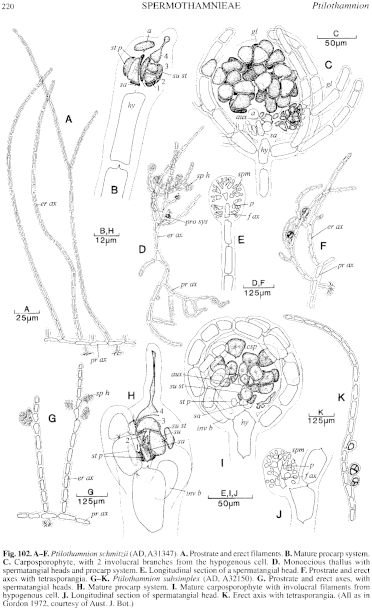|
|
|
|
|
|||||||||||
|
Electronic Flora of South Australia Species Fact Sheet
Phylum Rhodophyta – Order Ceramiales – Family Ceramiaceae – Tribe Spermothamnieae
Selected citations: Gordon 1972: 133, figs 42G–J, 43. Laing 1905: 387.
Thallus (Fig. 102A) 0.5–2 mm high, with branched prostrate filaments bearing sparingly branched erect filaments, on the surface or entangled with basal stupose rhizoids of the host. Epiphytic on Zonaria (or Homoeostrichus), or epizoic, attached by appressed or digitate haptera. Structure. Prostrate filaments 15–30 (–40) µm in diameter, cells L/D 1.5–4.5, erect filaments tapering only slightly, 15–20 µm in diameter, cells L/D 2.5–4.5. Cells multinucleate; rhodoplasts discoid.
Reproduction: Gametophytes monoecious or dioecious. Female axes (Fig. 102B) apical on erect filaments, with the last 2 cells comparatively short and the hypogenous cell longer and similar to vegetative cells. Procarps on the subapical cell, with two sterile periaxial cells and a supporting cell with a terminal sterile cell and a lateral carpogonial branch with cells of equal size. Post-fertilization fusion of carpogonial branch cells occurs but little other fusion and no fusion cell is formed. The auxiliary cell cuts off cells which form gonimolobes (Fig. 102C) of varying ages, with the cells of one gonimolobe maturing simultaneously into angular carposporangia 20–25 µm across. Sterile cells of the procarp do not divide, but the hypogenous cell produces, after fertilization, two involucral branchlets (Fig. 102C) which branch and curve around the carposporophyte. Spermatangial heads (Fig. 102D, E) occur terminally on erect filaments, slightly ovoid and 30–35 µm in diameter.
Tetrasporangia (Fig. 102F) occur on 1-few-celled pedicels on erect filaments, often forming unilateral series on upper branches, 40–45 µm in diameter, tetrahedrally divided.
Type from Bay of Islands, New Zealand; probably lost.
Selected specimens: Elliston, S. Aust., 28 m deep on Zonaria crenata (Shepherd, 23.x.1970; AD, A37480). Corny Point, Yorke Pen., S. Aust., drift on Z. spiralis (Gordon, 23.ix.1968; AD, A32164). Daly Head, Yorke Pen., S. Aust., drift on Z. crenata (Gordon, 26.iii.1967; AD, A31347). Glenelg, S. Aust., 4.5 m deep on ascidian (Cannon, 9.v.1987; AD, A58587). Somerton, S. Aust., drift on Z. crenata (Womersley, 13.vi.1966; AD, A46989). Port Noarlunga, S. Aust., 1 m deep on Z. spiralis (Shepherd. 27.vii.1968; AD, A32154). Judith Cove, West I., S. Aust., 3–5 m deep (Shepherd, 5.xi.1966; AD, A46990). Vivonne Bay, Kangaroo I., S. Aust., drift on Z. angustata (Womersley, 2.i.1949; AD, A48107). Port MacDonnell, S. Aust., drift on Homoeostrichus canaliculata (Womersley, 19.viii.1953; AD, A48110). Aireys Inlet, Vic., drift on Z. angustata (Macpherson, 23.xi.1957; AD, A48114). Flinders, Vic., upper sublittoral on Z. spiralis (Womersley, 18.i.1967; AD, A48112). Green Point, W coast Tas., deep pools on Z. angustata (Wollaston & Mitchell, 24.0.1964; AD, A48109). Wedge Bay, Tasman Pen., Tas., upper sublittoral on Z. angustata (Wollaston & Mitchell, 29.0.1964; AD, A48108).
Distribution: North I., New Zealand.
In Australia, Eucla, W. Aust., to Flinders, Vic., and around Tasmania.
Taxonomic notes: P. schmitzii is commonly found on various species of Zonaria, though often overlooked; it also occurs on ascidians. It differs from P. subsimplex in having all cells of the carpogonial branch of similar size, all carposporangia in a gonimolobe maturing together, and in the involucral branchlets on the hypogenous cell developing only after fertilization.
References:
GORDON, E.M. (1972). Comparative morphology and taxonomy of the Wrangelieae, Sphondylothamnieae and Spermothamnieae (Ceramiaceae, Rhodophyta). Aust. J. Bot. suppl. 4, 1–180.
HEYDRICH, F. (1893). Vier neue Florideen von New Zealand. Bet: dt. bot. Ges. 11, 75–79, Plate 22.
LAING, R.M. (1905). On the New Zealand species of Ceramiaceae. Trans. Proc. N.Z. Inst. 37, 384–408, Plates 24–31.
The Marine Benthic Flora of Southern Australia Part IIIC complete list of references.
Publication:
Womersley, H.B.S. (24 December, 1998)
The Marine Benthic Flora of Southern Australia
Rhodophyta. Part IIIC. Ceramiales – Ceramiaceae, Dasyaceae
©State Herbarium of South Australia, Government of South Australia
Illustration in Womersley Part IIIA, 1998: FIG. 102 A–F.

Figure 102 enlarge
Fig. 102. A–F. Ptilothamnion schmitzii (AD, A31347). A. Prostrate and erect filaments. B. Mature procarp system. C. Carposporophyte, with 2 involucral branches from the hypogenous cell. D. Monoecious thallus with spermatangial heads and procarp system. E. Longitudinal section of a spermatangial head. F. Prostrate and erect axes with tetrasporangia. G–K. Ptilothamnion subsimplex (AD, A32150). G. Prostrate and erect axes, with spermatangial heads. H. Mature procarp system. I. Mature carposporophyte with involucral filaments from hypogenous cell. J. Longitudinal section of spermatangial head. K. Erect axis with tetrasporangia. (All as in Gordon 1972, courtesy of Aust. J. Bot.)

|
Email Contact: State Herbarium of South Australia |

|